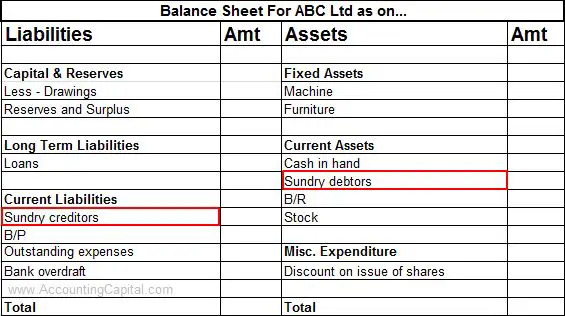Debtors vs Creditors
While purchasing goods on credit a buyer may not make the payment immediately instead both the seller and buyer may enter into a lending & borrowing arrangement. This allows delayed payments for current invoices. Even though payment terms are mutually agreed upon there is still a difference between debtors and creditors.
Typically such agreements involve a short interest-free credit period during which the buyer can make its payment. Debtors and creditors may be defined as follows;

Debtors – A person or a legal body that owes money to a business is generally referred to as a debtor in the eyes of that business, as he or she owes the money. For a business, the amount to be received is usually a result of a loan provided, goods sold on credit, etc.
Example – Unreal corp. purchased 1000 kg of cotton for 100/kg from X to use as raw material for their clothes manufacturing business. The total invoice amount of 100,000 was not paid by Unreal corp. In this example, Unreal corp. is a debtor for X.
Creditors – In day-to-day business, a person or a legal body to whom money is owed is known as a creditor. For a business, the amount to be paid may arise due to repayment of a loan, goods purchased on credit, etc.
Example – Unreal corp. purchased 1000 kg of cotton for 100/kg from vendor X. The total invoice amount of 100,000 was not received immediately by X. In this example, X is a creditor for Unreal corp.
Difference Between Debtors and Creditors (Table Format)
| Debtors | Creditors |
| 1. Debtors avail credit facilities as they borrow. | 1. Creditors extend credit as they act as lenders. |
| 2. It is a current asset for the business. | 2. It is a current liability for the business. |
| 3. Debtors are a result of credit sales by the business. | 3. Creditors are a result of credit purchases by the business. |
| 4. Discount is allowed on debtors. | 4. Discount is received from creditors. |
| 5. Total amount to be received (total debtors) is also known as Sales Ledger Control. | 5. Total amount to be paid (total creditors) is also known as Purchase Ledger Control. |
| 6. Collectively they form the company’s accounts receivables. | 6. Collectively they form the company’s accounts payables. |
| 7. Also known as Trade Debtors or Trade Receivables. | 7. Also known as Trade Creditors or Trade Payables. |
| 8. A provision for doubtful debts is created for debtors. | 8. No such provision or reserve is created. |
Shown in Financial Statements
Debtors and Creditors are both critical financial indicators and important parts of the financial statements of a company. Debtors form part of the current assets while creditors are shown under the current liabilities.
In the balance sheet

Vendor and Supplier
Is the supplier a creditor or debtor?
A supplier is usually the first link in a supply chain. It does not indulge in the inventorying processes and provides goods that are further processed in the supply chain. The concept of supplier is more commonly found in B2B chains.
Going by common practice, a supplier will be a creditor of the company. Assuming that the business is buying its raw material from a supplier on a regular basis, and then adding some value to them and manufacturing a finished product for the market.
Example: A restaurant owner X is buying vegetables from a farm owner and making dishes for customers. There is a value addition to the vegetables in this case. Also, the farm owner is most likely not selling these vegetables to retail consumers and just supplying them to various restaurants.
Is a vendor a creditor or a debtor?
A vendor is usually the last link in a supply chain. A vendor involves in the process of buying from one company and selling to the other. It can be both B2B and B2C kind of the supply chain. It generally does not involve manufacturing or value-adding processes
Usually, a vendor can be both a debtor and a creditor of the business. Since a vendor may be providing the company with some kind of finished products and also can be buying the same products from another company.
Example: The same restaurant owner X may not want to indulge in ice cream making and is just buying desserts from a vendor on a regular basis, making him a creditor for X. On the other hand, the same vendor may be buying these desserts from a dairy business B, making him a debtor for B. There is no value being added other than packing and shipping in this case and there is inventorying involved.
Is Debtor and Creditor Asset or Liability?
An asset is something that inhibits future benefits. These are economic resources that are owned by the business and can be measured in monetary terms. Going by this definition, a debtor is an asset to the business.
- Since a debtor represents a financial obligation for the entity to repay in the future, putting the business on the receiving end.
- Debtors owe cash benefits to the business and hence are classified as current assets in the balance sheet.
On the other hand, liabilities are the amounts that a business entity has to pay. Liabilities can be both internal and external. By this definition, creditors are an external liability for the business.
- Creditors inhibit future cash outflow for any business. This amount reduces with payments to the entities that the business owes money.
- Creditors are classified as current liabilities on the balance sheet.
Revision & Highlights Short Video
Highly Recommended!!
Do not miss our 1-minute revision video. This will help you quickly revise and memorize the topic forever. Try it :)
Read Difference Between Carriage Inwards and Carriage Outwards
